Your Planets
Portraits of the Planets
Aspects between Planets
The planetary ages
The planetary families
Planets in Signs
The Planets in comics


Twelve years already! Time for Jupiter to come full circle around the Sun, and the confident, optimistic and conformist child of the jupiterian stage suddenly transforms, at the end of his twelfth year of existence, into an anxious, pessimistic and rebellious adolescent. It must be said that a new planet takes over its evolution: it is about Saturn, whose sidereal revolution time is about thirty years. From twelve to thirty years old, therefore, the one who is not yet an adult and no longer quite a child will transform to the rhythm of Saturn.

The Saturnian stage, like the Jupiterian, is characterized by its long duration: no less than eighteen years! Beginning with puberty, it thus encompasses adolescence and the first steps into adulthood. to the planet Saturn, astrological tradition attributed melancholy, meditation, taste for abstractions, introversion, frustration, loneliness. She has made it the star of the silent, of the scholars, of the wise. Nothing to do with Jupiter then…
Around the age of twelve on average, puberty is manifested by accelerated and anarchic physiological growth. Sexual organs and reproductive functions mature. The child grows, becomes stronger, more enduring. A page has been turned, that of carelessness with rounded and chubby shapes. The teenager quickly finds himself in a new skin, a foreign body which he must get to know while the world appears to him in all its complexity.
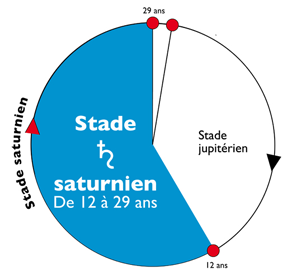
At the age of twelve, the child had achieved an excellent physical and mental balance. Dynamic, sociable, good-natured, well integrated into his environment, he exudes self-confidence, the joy of living. And then suddenly, in the thirteenth year, everything is called into question. His character becomes unstable, changing, his reactions disconcerting. The horizon of his life, which until now was limited to family, school and friends, suddenly seems narrow to him: he wants to broaden it, develop new centers of interest. It often happens that he plunges into long periods of silence, of morose daydreaming, of disenchanted meditation, of refusing dialogue with his parents. He questions himself, he interiorizes himself by asking questions about himself. This internalizing awareness is coupled with an externalizing awareness: he now seeks to understand the functioning of the outside world.
At the previous stage, the child was rather expansive, extroverted, confident, little inclined to think about abstract problems or, according to him, useless. Now he delves deeper into his own reality and that of the beings, things and situations around him. He no longer understands himself and no longer understands the world. Reality raises questions, poses a problem; the certainties of childhood disappear to give way to perplexity, at worst to immense disarray, at best to intense reflection. Existence is no longer self-evident. He loses his concrete landmarks.
The adolescent therefore experiences a disimplication, a distancing from the solicitations of the surrounding environment. He considers his experience with more hindsight than before. There is nothing simple about existence, no childish and reassuring standard can any longer be accepted a priori. It must first be the object of internalization, of a critical personal re-elaboration, at the end of which it may end up being rejected. He must personally experience the complexity of the internal world (“Who am I, where do I come from, where am I going?”) as from the external world (“The world is not as simple as I thought it was when I was a child”). Thus the adolescent often finds himself alone, if not isolated, thoughtful, distraught, inclined to self-analyze and question the entire universe. The difficulty of putting an end to the world of childhood, like the impossibility of situating oneself in that of adults, can be at the origin of his melancholy, his revolt or his aspiration for an absolute that transcends him.
Adolescence is the period of birth of what the psychologist Jean Piaget calls the “formal operations” : the child becomes able to reason from statements, abstract hypotheses, propositions, barely sketched possibilities, probabilities, in short various acute cerebralizations from what could be true. Whereas until the age of twelve he could only develop his logic from the fixed idea he had of his concrete situation, by trying, for example, to classify and list visible or immediately represented objects, his thinking can now develop from verbal or symbolic elements. The most gifted learn to juggle mathematical and/or philosophical equations and abstractions.
He only admits the facts once they have been verified and tested through a multitude of hypotheses, which pushes him to challenge all received ideas, all evidence. He no longer asks himself and no longer asks others the same questions as the ten-year-old child. even the most relevant and sensible answers to his “Why” no longer satisfy him. He no longer spontaneously accepts the explanations imposed on him, according to him authoritatively. For him henceforth, a fact is accepted as such only insofar as it proceeds from general laws determining its existence and making it logically necessary: in the adolescent there is a requirement of rationality. He no longer asks himself and no longer asks others “Why, for what purpose?”, but “Why, really?”
Of course, such an attitude is initially very disturbing and destabilizing for parents and educators. Is that why we called adolescence “the ungrateful age” or “the silly age” ? Still, the child of this age who quibbles, pursues his reasoning to the point of absurdity and systematically disputes the slightest instruction, seems to have lost all the common sense that characterized him until then and thus gives the impression of regress. Is it really regressing? Not at all, quite the contrary: through this initially chaotic and anarchic approach, he demonstrates that he questions reality and adults in depth to elucidate their laws of organization. He does not hesitate to wonder about all possible eventualities, even the most apparently absurd or improbable. He wonders if, alongside or beyond the answers given to him, might not exist another logic, hidden, veiled, mysterious. Whatever the answers or solutions offered by the facts or the adults with whom he is confronted, he always remains fundamentally dissatisfied. According to him, something else is possible… He thinks!
Between twelve and fourteen years of age (fourteen years is the duration of Saturn’s half-cycle), the adolescent may be tempted, in his sometimes irrational way, to rationalize excessively, to exercise his abstract thought only on pure verbal propositions that he dissects and casts doubt on, neglecting the reality of the facts. Formalism, dogmatism await his mind disconnected from concrete realities. Yet these are only the gropings of a thought that seeks itself. The realm of possibilities is nevertheless often confused with that of the arbitrary, of the imaginary: the adolescent, by freeing himself unilaterally from all objectivity, by being immensely confident in the transforming power of thought, abandons himself to the delights of intellectualism. He theorizes excessively, and it does not matter if his theories are mostly fragmentary, stereotyped or simplistic. In “theorizing” thus, he exercises an activity of pure intellectual speculation.
It is also after twelve years, during the Saturnian stage, that the first social, political or philosophical awareness appears. The adolescent no longer identifies as the child with parental or school models. He seeks his truth elsewhere, exercising his abilities for abstract thought without restriction or caution, sometimes even losing all contact with reality and believing himself capable of solving all problems thanks to the power of his thought alone. In fact, he is not satisfied with what is and he extrapolates, from the data of reality or discourse, how and why it could and should be otherwise, endlessly remaking the world, haunted by an absolute and intransigent idealism, sometimes fanatical.
More positively, this concern for theorizing the world also translates into a taste for in-depth understanding, a sense of the complexity of beings, things and situations, the ability to create personal thought, a taste for mystery and hidden structures. It is no coincidence that statistics have shown that Saturn is very frequently dominant in the birth charts of doctors and scientists, generally favored, it is true, by a social and family environment conducive to long and costly studies.
It is no longer enough for adolescents to experience interpersonal relationships in the family or school setting. He wants to be considered as an adult, to fit into their social body, to participate in their ideas, ideals or ideologies if only to challenge them, all things that left him indifferent before the age of twelve. While seeking to adapt his ego to his social environment, he wants to force the social environment to adapt to his ego. Not easy! We are in any case very far from the conformity of the child at the previous stage.
On the one hand, the adolescent often feels lonely, unloved, misunderstood and willingly takes refuge in pensive, dreamy or melancholy isolation. But on the other hand, one notices in him an increasingly pronounced tendency to associate with other adolescents to form “bands”. Perfect asociality on the one hand (in reaction to masters, models and various educators), very powerful group instinct on the other. Paradox? In fact, both are necessary for the edification of formal thought and the maturation of its personality, at the same time as dependent on his ungrateful status: rejected from the reassuring and naive world of childhood, he does not yet have access to the adult world, of which he nevertheless feels the equal in many respects.
Groups of adolescents are therefore groups of loners. Feeling misunderstood by adults, they hope to understand each other and come together on the basis of secret elective affinities. This social life allows the adolescent to decenter himself intellectually and to discover, by confronting his ideas with those of others, that multiple points of view are possible, and that his is not always valid. He realizes that behaviors can be interpreted differently, he learns to identify the hidden and deep motives of his fellow men, whereas he did not care at all to understand the personality of adults and his playmates when he was a child. With those of his gang, he learns a new style of sociability in the complex interactions between different individuals in search of their own identity, challenging the rules of the game and the values of adults and forging new ones.
Also important are the quest for new role models and image problems among adolescents. These transitional models (movie stars, singing stars, sports champions, various heroes) serve to fill the sudden identity vacuum with which he finds himself confronted. The parental or school models, which were and remain imposed figures, are no longer enough for him. Whether he contests them or not, he now seeks his ideals and his identifications elsewhere, and above all he intends to choose them freely, in complete independence. He wants them to correspond to his deep personality without really knowing it yet. Whence these hysterical and desperate identifications which one observes in certain “fans” idols of showbiz, sects, sports or political parties, which moreover cease as soon as the adolescent learns to no longer confuse, as he did in his identity panic at the beginning of the stage, real and proper identity and temporary identification-prosthesis.
Self-image problem: he does not “recognize” more indeed in the physical image of himself that he had until now. Her body was transformed, her voice changed and the appearance of genital sexuality, while modifying her bodily reactions, came to introduce a dimension of unfathomable mystery at the heart of her being. Very often, he does not like himself, does not like himself, depreciates himself: he finds himself too tall or too short, too fat or too thin, uncomfortable in this mutant body crossed by sensations hitherto unknown. He not only no longer knows who he is, but also ignores what he represents.
The adolescent spends a lot of time in front of the mirror, and cares a lot about his appearance, in the anxious search for a moving, unstable, constantly changing and often objectively ungrateful self-image (juvenile acne!). In front of the mirror or in the choice of clothes which is personalized, he does not do narcissism but in fact addresses an imaginary audience and public which allow him to try to evaluate what effect he produces. He painstakingly reconstructs, in doubt and uncertainty, his body image.
Personal storytelling is also part of these problems of early-stage adolescent egocentrism, which do little to facilitate interpersonal relationships: the increasingly pronounced personalization of character involves the feeling of feeling different, unique, incomparable, but also misunderstood. The adolescent has the image of himself as a special person, irreducible to any category whatsoever and imposes his painful ego on his peers in an exacerbated way, even if it means adopting shocking appearances to stand out from the others.
Adolescence sees the appearance of deep feeling, the internalized development of childhood affection, as well as the maturation of genital sexuality, which is gradually freed from the inhibitions, taboos and prohibitions of childhood. Previously, everything was simple: there were little boys on one side, little girls on the other, and the two groups rarely mixed to play together. From now on, the adolescent is confronted with the problem of sexual choices and desires: between the ages of twelve and fifteen, we know that there is a period of latent homosexuality, which is followed by an elective orientation: hetero, homo or bisexuality. Here again, he is looking for himself and doubts his sexual identity… like everything else!
The feeling of love does not appear to be specific to adolescence. There are children in love. The difference between the child and the adolescent in love is however significant: while the first lives his feelings in a simple and immediate affective projection, the second complicates his feelings, constructs novels about them. Feelings on edge of course, but always difficult to express through language. Where the child does not even imagine that his love is not shared by the one of whom he is the object, the adolescent questions himself feverishly, probes his heart and that of the other to know if he loves or s does not love, if he is loved or not, how far does this love go and what is it made of, and how long will it last? The adolescent is a solitary and frozen lover, with deeply internalized and uncertain affects, in short, a romantic ready for all sentimental outpourings but so clumsy to come out of his isolation to communicate his emotions… if not to his diary or to his or her best friend)!
It is also from the age of twelve that a new feeling appears: friendship. Until the age of twelve, it was the “buddies time”. The special relationships that the child established with one or more other children were above all based on sharing games or common school or sports activities. It is a relatively superficial, utilitarian, circumstantial type of relationship, where no one is deeply invested. Buddies are interchangeable. Friendship is quite different: like love, it is a privileged relationship based not only on common affects, reciprocal sympathy, but on the same vision of the world, intellectual affinities. The adolescent is very discriminating and selective in the choice of his friendships: friendship is born of a personal choice, and the friend will be the great confidant, the one to whom one can tell his secrets, his doubts, his dissatisfactions, his perplexities without fear of being betrayed or judged.
The acquisition of abstract reasoning allows the adolescent to understand and internalize universal moral principles. It is no longer a question of externally assimilating permits and prohibitions, but of understanding the deep and necessary why, in a context of relativity. The morality of the principles freely accepted as his appears between twelve and thirty years (during the Saturnian stage) or never, according to many specialists. This level of morality goes beyond the simple “fear of the policeman” which often characterized childish morality. The adolescent may be confronted with a possible conflict between two different types of norms accepted by society and be forced to make a choice: should he follow the example of his parents or of a teacher of whom he disapproves conduct when he owes them obedience, or disobey them in the name of other values that require obedience to standards foreign to those of his educators? Difficult dilemmas…
At the highest level (very few are those who reach it), adolescent age allows access to the morality of individual principles of conscience: the individual then does what he himself, as an individual, considers as well, without taking into account legal constraints or the opinion of others and without seeking by this exemplary behavior any gratification, any social reward. He acts in accordance with his own internalized moral values, knowing that he would blame himself for not doing so.
Not all teenagers are moral or moralistic. On the contrary: many are those who, in this interval of time, enter into rebellion against any morality imposed by the family, school or society. We then find again the protesting, rebellious, rebellious, anarchist side of the adolescent in the problems of juvenile delinquency, rejection of any rules of the game, any submission to a binding collective order.
Adolescence requires disciplining the “Me” childish, to develop his own personality in order to enter adult society. Nagging questions of the teenager: “who am I?” but also “What will I do later, what will become of me?” Contradictions: on the one hand, he would like to take a step back, give himself the time to reflect on all the social obligations to which he adhered without asking questions and submitted so far with good grace. On the other hand, the unknown represented by the future excites him. He will be able to deploy himself there, discover himself there, finally build his life there in complete independence. Seen from the outside, the adolescent seems to be excessively interested in abstract or irrelevant problems (“Instead of daydreaming, you better think about doing your homework!”). But seen from within, the adolescent’s approach is to step back the better to jump, to gain scope with regard to the immediate to better embrace all the possibilities that his future conceals: this is his paradoxical interest.
By absenting himself from his present, the adolescent makes himself available for the future. He wants to be the equal of the adult, and judges him on a plan of total and complete reciprocity… But before becoming an adult, he must sort out his concerns, his desires, his desires, his thoughts, work out a program of life, strengthen his will, ward off his anxious questions, his paralyzing uncertainties, forge a conception of things that allows him both to affirm his own personality and to be creative, to do better than his predecessors and try to change the world.
To fit into the adult world while transforming it, trying to do better according to their scale of values: such is, at the highest level, the ambition of the adolescent. His quest for the absolute is demanding and for him, his future is not written anywhere. It is a virgin territory to explore, an unknown land to discover and appropriate. And if he knows well that he will be forced to adopt a social role, he firmly and fervently hopes that he will succeed in creating his own role by playing it, rather than passively accepting to take his place in society. as if it were only a matter of identifying with a stereotyped administrative function.
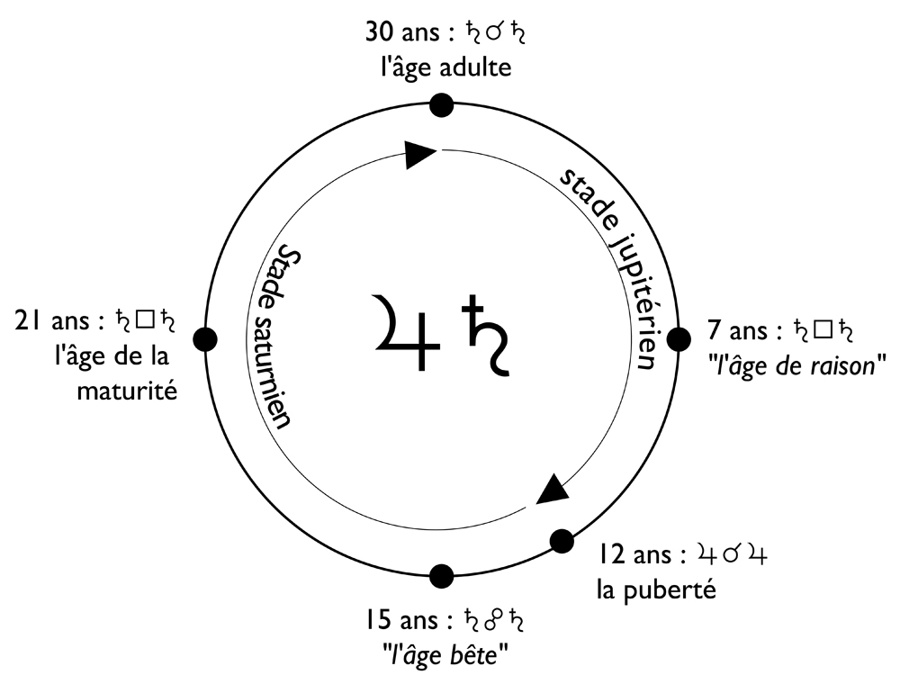
Adolescence proper ends on average around the age of twenty or twenty-one… even if some remain eternal teenagers all their lives. In fact, by dividing more finely this long slice of eighteen years that constitutes the Saturnian stage, we realize that we can subdivide it into three characteristic sub-periods:
▶ twelve to fifteen years old takes place the “pubertal crisis”. During this “dumb age” or “ungrateful age” (which is not stupid but very ungrateful), the adolescent exhibits a rebellious and tormented egocentrism, worries about everything, suffers from acute identity problems, feels lonely and misunderstood and tends to systematically challenge parental or school authority. This is an extremist and primary way of manifesting its newfound autonomy.
▶ fifteen to twenty-one years old, the adolescent (in an evolution “normal” which depends on social and family circumstances) gradually stabilizes, loses its subjectivity and its egocentrism, and gradually begins to admit that it is not alone in the world, that others have other concerns, interests and concerns than his. He becomes wiser, more responsible, less flayed, his critical spirit is better targeted, he reflects more pertinently on his own identity and better perceives his place in society.
▶ from twenty-one to thirty years old, in the same evolution “normal” and ideal, the adolescent turns into a young adult. He is still researching, but his centers of interest have stabilized, he has mastered his independence and his autonomy, he now accepts himself as he is, with his strengths and weaknesses, his doubts and his plans for the future. If he is always ready to question his achievements, his first emotional or professional choices, he savors the freedom to live according to his own standards, sometimes very far from parental values.
Twelve, fifteen, twenty-one, thirty years: these ages which frame and mark adolescence are precisely related to the sidereal cycle of Saturn. At age twelve, the first cycle of Jupiter ends. At about fifteen years old, Saturn is in its half cycle: it is opposite to the position it occupied at birth. At twenty-one, he has completed three-quarters of his cycle and finds himself at 90° from his native position, i.e. in square aspect. At thirty, Saturn’s first cycle ends. According to astrology, but also according to many relevant observers of human development, adolescence really ends around thirty.
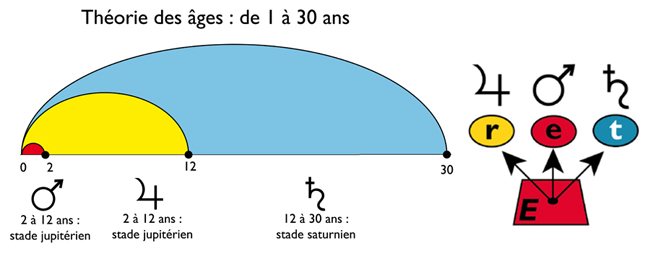
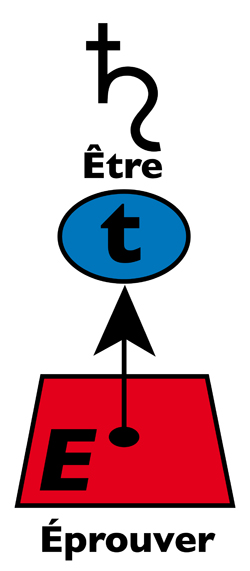
We are in saturnian state, like a teenager or a young adult from 12 to 30 years old, when we are confronted with complex situations, rebellious objects, facts that rebel against our expectations, when we are fundamentally dissatisfied with the way in which our existence is unfolding. We are in a Saturnian state when concrete events leave us perplexed, dubious, uncertain about the way forward, when we prefer to carefully explore the full range of possibilities, all eventualities, all hypotheses before making difficult, demanding decisions, carefully considered. We are in a Saturnian state when at the time of evaluating a being, a thing, a situation, we distrust evidence, accepted certainties, known recipes, which we prefer to observe and analyze phenomena carefully and at length before making an opinion, to make a judgment, to opt for a direction knowing that it may be questioned.
We are still in a Saturnian state when we introduce between ourselves and others a relationship of distance, coldness, detachment, when we tear ourselves away from our present to take the time to reflect, to think, to dissect our experiences in order to try to understand its deeper meaning. We are in a Saturnian state when we take a step back from events, when we prefer to be alone than in bad company, when we doubt ourselves and others, when we exercise our critical sense and our experimental skepticism with regard to those who speak too loudly, who are always sure to be right, who parade on the front of the stage, even if it means finding ourselves sometimes alone and misunderstood.
We are always in a Saturnian state when we do not hesitate to take on binding, thankless, difficult responsibilities, when we engage in selfless actions with problematic success, when we wonder with worry or hope what tomorrow will bring, when we seek to protect ourselves against the uncertainties of the future by being prudent, far-sighted and methodical. We are in a Saturnian state when we seek in our efforts only personal satisfaction and not social recognition, when we are instinctively wary of facade compromises, when in action we refuse easy solutions and complacency.
We are finally in a Saturnian state when we question ourselves about the hidden meaning of life, about the secret motives of our motivations or those of others, when what we experience always leaves us in a state of lack, a feeling of incompleteness, in the certainty that basically the essential always eludes us. We are in a Saturnian state when we are alone with ourselves and facing the unknown of the world, when we abstract ourselves from the contingencies of the moment to imagine or foresee other possibilities, when we ask ourselves if our existence is not absurd, or when we aspire to know the unspeakable truth, the transcendent absolute, the secret and discreet invariant nestled and hidden at the heart of the existence of beings and things.
With a strong and dominant Saturn, we are more frequently than others skeptical of the obvious, critical, withdrawn, distant, doubtful, prey to a chronic dissatisfaction which favors the taste for research, adventure, deep reflection, imagination and questioning. If, on the contrary, Saturn is undervalued in the birth chart of an individual, he will more often than others find it difficult to measure and foresee the distant consequences of his actions, to flourish in studious or simply pensive solitude, to decant his experiences and behaviors to analyze the hidden workings and secret motivations.
▶ The Saturnian: Psychological profile
▶ The saturnian function ‘tE’ (transcendence of Existence)
▶ Mars-Jupiter-Saturn: extensive Existence
▶ Mercury-Saturn-Pluto: intensive transcendence
▶ Saturne et le système osseux : de l’analogie à la biologie
▶ Introduction to the Theory of Planetary Ages
▶ L’échéancier planétaire et la Théorie des âges
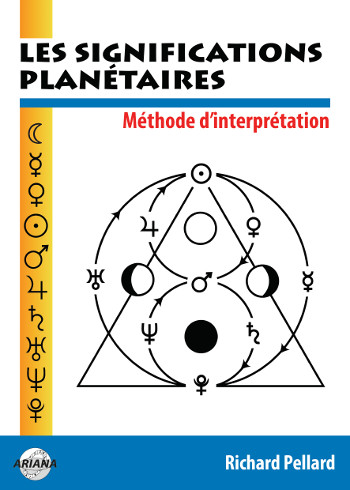
Les significations planétaires
par
620 pages. Illustrations en couleur.
La décision de ne traiter dans ce livre que des significations planétaires ne repose pas sur une sous-estimation du rôle des Signes du zodiaque et des Maisons. Le traditionnel trio Planètes-Zodiaque-Maisons est en effet l’expression d’une structure qui classe ces trois plans selon leur ordre de préséance et dans ce triptyque hiérarchisé, les Planètes occupent le premier rang.
La première partie de ce livre rassemble donc, sous une forme abondamment illustrée de schémas pédagogiques et tableaux explicatifs, une édition originale revue, augmentée et actualisée des textes consacrés aux significations planétaires telles qu’elles ont été définies par l’astrologie conditionaliste et une présentation détaillée des méthodes de hiérarchisation planétaire et d’interprétation accompagnées de nombreux exemples concrets illustrés par des Thèmes de célébrités.
La deuxième partie est consacrée, d’une part à une présentation critique des fondements traditionnels des significations planétaires, d’autre part à une présentation des rapports entre signaux et symboles, astrologie et psychologie. Enfin, la troisième partie présente brièvement les racines astrométriques des significations planétaires… et propose une voie de sortie de l’astrologie pour accéder à une plus vaste dimension noologique et spirituelle qui la prolonge et la contient.
Téléchargez-le dès maintenant dans notre boutique
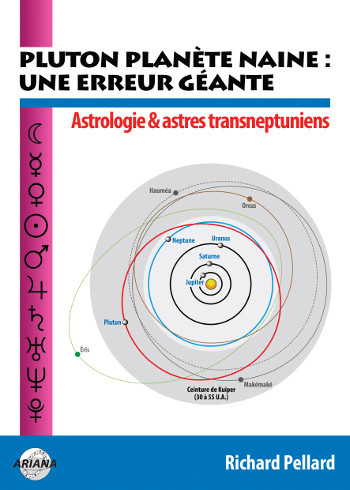
Pluton planète naine : une erreur géante
par
117 pages. Illustrations en couleur.
Pluton ne fait plus partie des planètes majeures de notre système solaire : telle est la décision prise par une infime minorité d’astronomes lors de l’Assemblée Générale de l’Union Astronomique Internationale qui s’est tenue à Prague en août 2006. Elle est reléguée au rang de “planète naine”, au même titre que les nombreux astres découverts au-delà de son orbite.
Ce livre récapitule et analyse en détail le pourquoi et le comment de cette incroyable et irrationnelle décision contestée par de très nombreux astronomes de premier plan. Quelles sont les effets de cette “nanification” de Pluton sur son statut astrologique ? Faut-il remettre en question son influence et ses significations astro-psychologiques qui semblaient avérées depuis sa découverte en 1930 ? Les “plutoniens” ont-ils cessé d’exister depuis cette décision charlatanesque ? Ce livre pose également le problème des astres transplutoniens nouvellement découverts. Quel statut astrologique et quelles influences et significations précises leur accorder ?
Enfin, cet ouvrage propose une vision unitaire du système solaire qui démontre, chiffes et arguments rationnels à l’appui, que Pluton en est toujours un élément essentiel, ce qui est loin d’être le cas pour les autres astres au-delà de son orbite. Après avoir lu ce livre, vous saurez quoi répondre à ceux qui pensent avoir trouvé, avec l’exclusion de Pluton du cortège planétaire traditionnel, un nouvel argument contre l’astrologie !
Téléchargez-le dès maintenant dans notre boutique